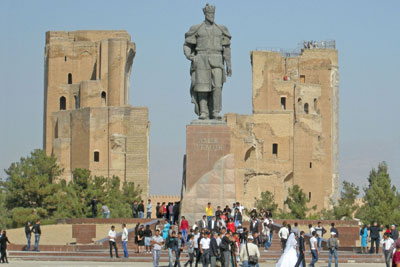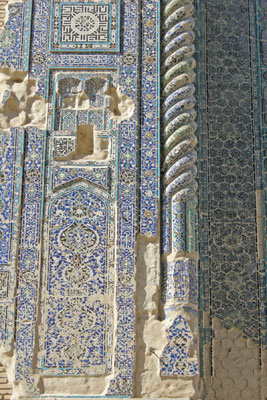Timur’s summer palace
This item appears on page 33 of the April 2014 issue.
Tamerlane, also known as Timur the Lame and Amir Timur (1336-1405), is probably the best-known ruler of ancient Central Asia. Pictures of his mausoleum — the Gur-e Amir, located in Samarkand, Uzbekistan — are among the photographs most often seen in the travel literature on Central Asia.
The remains of Timur’s most ambitious construction, however, are found some 50 miles south of Samarkand in Shakhrisabz, known in his day as Kesh.
The town of Shakhrisabz, Timur’s birthplace, was once one of Central Asia’s most important cities. Its primary attraction is the ruined Ak-Saray, Timur’s summer palace. Its construction is said to have begun in 1380, and a surviving inscription gives the date of the palace’s completion as “798 A.H.,” or 1395-96 CE (AD 1395-96). However, further construction and embellishment went on until Timur’s death in 1405.
All that is left of the grandiose structure is a pishtaq, the projecting elements of an iwan (a large, formal gateway). The monumental gateway probably stood 70 meters (230 feet) in height, with an arch spanning nearly 23 meters (76 feet).
Unfortunately, time didn’t allow me to climb the 116 steps to the top of one of the ruin’s towers, where I could have more fully appreciated the immensity of the palace’s former size.
Even in its fragmentary remains, I was amazed by the refinement of the tile designs and the sophisticated colors of the blue, white and gold glazed decoration. I also was impressed by the complex geometric ornamentation, the exquisite foliate designs and the inscriptions from the Koran.
Today, a modern statue of Timur stands in what was once the huge palace’s center. While I was there, the statue was surrounded by wedding parties taking photographs.
My visit to the Ak-Saray was one of the highlights of my October ’13 trip to Central Asia, along with major sites visited in Uzbekistan’s Samarkand and Bukhara and especially those in the well-preserved medieval city of Khiva.
DAVID J. PATTEN
St. Petersburg, FL


